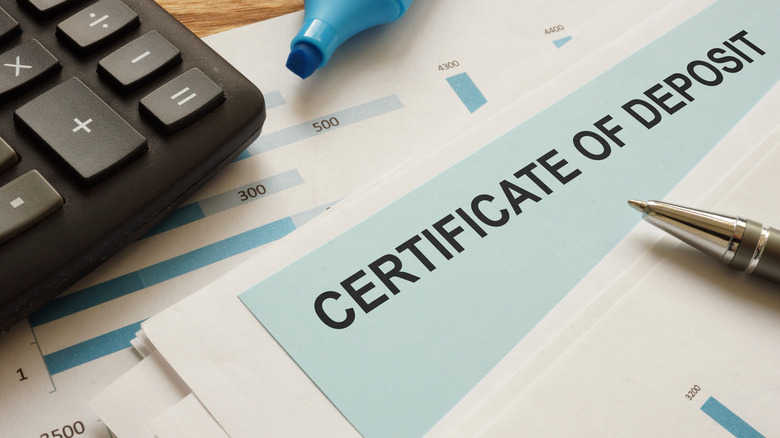The Pros And Cons Of Opening A 10-Year CD Savings Account
When it comes to guaranteed ways to save more money, it's hard to find a more surefire approach than with a certificate of deposit (or CD). While not the most high yield option out there, most consumers would be hard pressed to find a safer way to ensure your money grows over time. As a refresher, CDs involve a consumer depositing a certain amount of money that is essentially locked-in to that CD for a predetermined amount of time. In exchange, the CD has a guaranteed annual percentage yield, or APY — aka the rate of return — that you can expect to receive once the CD has reached its full maturity, or rather, the end of the term of the CD. The most common CD terms a consumer is likely to see offered are three months, six months, one year, two years, three years, and five years.
While CDs can offer many positives, and offered seriously competitive rates in 2024, it's worth knowing that, starting in September 2024, when the Federal Reserve started lowering its federal funds rate, CD rates have been declining. This leaves short-term CDs less appealing than they once were, and might leave some consumers wondering about longer-term commitments. In particular, 10-year CDs could be a particularly useful approach for those looking to save money in a low-risk way. However, before committing to a decade of tied-up funds, it's best to consider the pros and cons of pursuing a 10-year CD, and whether or not other options might be the better choice for your financial situation.
Pros of a 10-year CD
10-year CDs generally offer higher, and more attractive, APY rates than CDs with shorter terms. Similarly, this rate would likely outmatch any competitive high-yield savings accounts you might find. Best of all, because the rate is fixed you don't have to worry about the potential for the bank to change the rate they're willing to offer you — something that isn't guaranteed with variable rate offerings like high-yield savings accounts. This predictability can be particularly helpful for anyone looking to plan ahead with absolute precision. It can also help you avoid some of the volatility that can come with ever-changing interest rates, not to mention the will-they or won't-they nature of the Federal Reserve's interest rate decisions.
Another consideration for 10-year CDs is their relatively low risk. This can make them particularly beneficial for consumers with higher risk aversion. Since CDs are generally backed by FDIC-insured institutions, your money is guaranteed to be returned to you – even in the event your bank goes under — up to the FDIC limit of $250,000. With that said, it's important to realize that this FDIC limit applies to a single depositor in a single institution meaning if you also have your checking and/or savings account at the same bank that issued your CD you'll want to make sure your overall combined total in any singular institution doesn't exceed this limit. Otherwise, you could find yourself out of your own money.
Cons of a 10-year CD
First and foremost, a decade is a long time. Not only is it a long time to have your money tied up, but it can also be long enough to face very different economic circumstances by the end of the time period. Between ever-changing inflation, you might find that whatever APY rate you agreed to at the beginning of the CD ends up being outpaced by growing inflation, effectively ensuring you lose purchasing power on your money over the course of potentially years.
It's also worth considering whether the APY rate offered on your 10-year CD can be found somewhere else that provides more flexibility. For example, with interest rates remaining high, many high yield savings accounts are offering APY rates as good, if not better, than most CD rates, without the same time commitment involved. With that said, high-yield savings account rates are ultimately variable, meaning they are subject to fluctuation unlike fixed CD interest rates.
Another consideration is how much less competitive CDs have become over the decades. In fact, according to historic CD data from Bankrate, the average APY on a one-year CD was over 11%, and over 12% on a 5-year CD, in 1984. Since then, the average offered APY on CDs has declined dramatically, and steadily. You might instead find that a 10-year Treasury note is a better choice for you, as these offer fixed interest rate payments every six months until they are fully matured. Plus, Treasury notes can be sold to someone else if you find you need to get the money out early.


